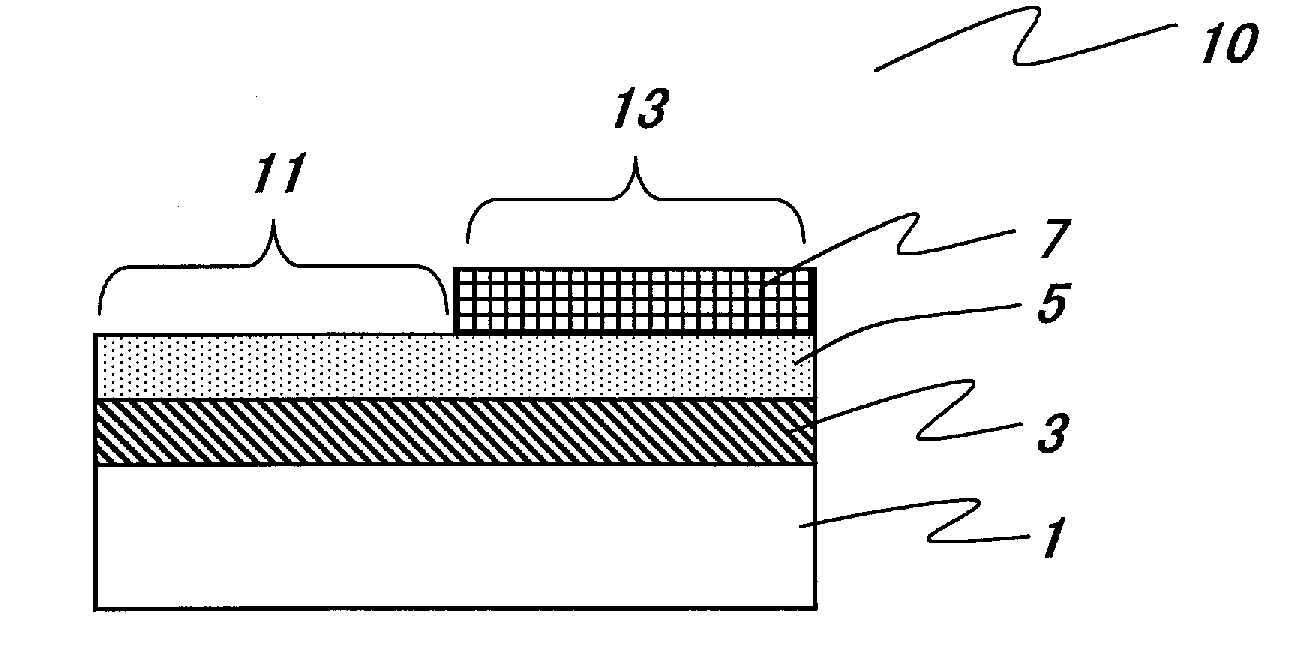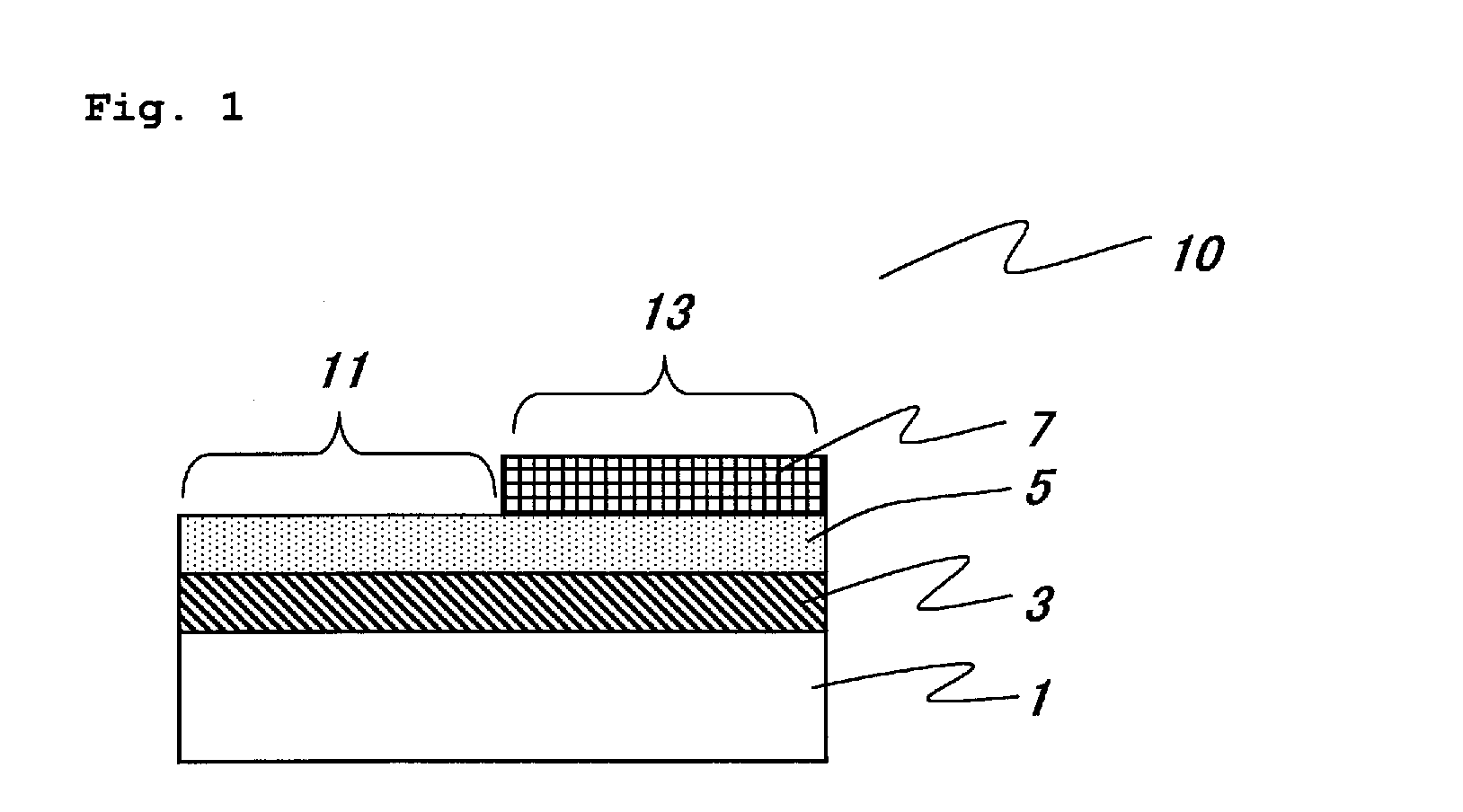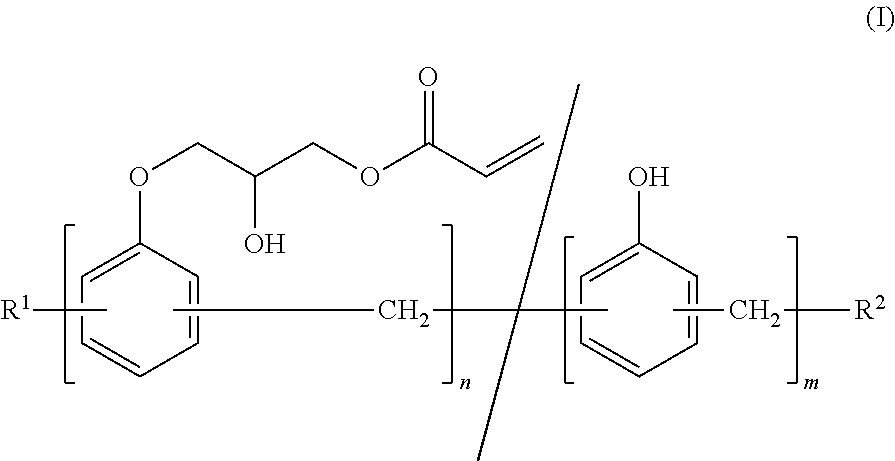Electroconductive laminate and touch panel using thereof
a technology of electroconductive laminate and touch panel, which is applied in the direction of instruments, other domestic objects, synthetic resin layered products, etc., can solve the problems of deteriorating visibility of interference fringes, generating cohesive failure of the substrate surface, and deteriorating appearance of interference fringes, etc., to achieve excellent hardness, high visibility, and high refractive index
- Summary
- Abstract
- Description
- Claims
- Application Information
AI Technical Summary
Benefits of technology
Problems solved by technology
Method used
Image
Examples
production example 1
Production of a Phenolic Novolac Acrylate (1)
[0156]In a reaction vessel equipped with a stirrer, a thermometer, a dropping funnel and a reflux apparatus, 150 g of phenol novolac resin (a weight average molecular weight of 700 to 900, an epoxy equivalent of 150 to 200) and 550 g of epichlorohydrin were mixed, and 110 g of an aqueous solution of sodium hydroxide (48.5%) was added dropwise for 2 hours under a temperature of 100° C. and a reduced pressure of 100 to 200 mmHg.
[0157]After the reaction was finished, a reaction temperature of the reaction mixture was lowered to a room temperature, and excess amounts of an aqueous solution of sodium hydroxide were neutralized with an acid, then the reaction mixture was heated under a reduced pressure to remove excess amounts of epichlorohydrin.
[0158]Next, the resulting reaction mixture was dissolved in methyl isobutyl ketone, and a salt of byproduct was removed by water filtration to obtain a solution of phenol novolac epoxy resin.
[0159]To th...
production example 2
Production of a Phenolic Novolac Acrylate (2)
[0161]In a reaction vessel equipped with a stirrer, a thermometer, a dropping funnel and a reflux apparatus, 150 g of phenol novolac resin (a weight average molecular weight of 900 to 1100, an epoxy equivalent of 150 to 200) and 550 g of epichlorohydrin were mixed, and 110 g of an aqueous solution of sodium hydroxide (48.5%) was added dropwise for 2 hours under a temperature of 100° C. and a reduced pressure of 100 to 200 mmHg. After the reaction was finished, a reaction temperature of the reaction mixture was lowered to a room temperature, and excess amounts of an aqueous solution of sodium hydroxide were neutralized with an acid, then the reaction mixture was heated under a reduced pressure to remove excess amounts of epichlorohydrin.
[0162]Next, the resulting reaction mixture was dissolved in methyl isobutyl ketone, and a salt of byproduct was removed by water filtration to obtain a solution of phenol novolac epoxy resin.
[0163]To the re...
production example 3
Production of Polyfunctional Urethane Acrylate
[0165]In a four-necked flask of 1 L equipped with a thermometer, a cooling tube, and a stirrer, 341 g of polycarbonate diol of 1,5-pentanediol and 1,6-hexanediol (manufactured by Asahi Kasei Chemicals Corporation, PCDL T-5652, number average molecular weight: 2000), 17 g of acrylic acid adduct of 1,6-hexanediol diglycidyl ether (manufactured by Showa Highpolymer, Ripoxy SP-16LDA), 43 g of isophorone diisocyanate, 0.2 g of dibutyltin dilaurate (reaction catalyst), and 400 g of methyl ethyl ketone (organic solvent) were added, and reaction was performed while stirring at 70° C. for 24 hours. After the reaction, it was confirmed that no isocyanate residue was observed by infrared absorption spectrum. As a result, unsaturated group-containing urethane resin (polyfunctional urethane acrylate) having 30,000 of a number-average molecular weight and a degree of unsaturation of 0.23 mol / kg was obtained. The obtained Polyfunctional urethane acryla...
PUM
| Property | Measurement | Unit |
|---|---|---|
| refractive index | aaaaa | aaaaa |
| thickness | aaaaa | aaaaa |
| average primary particle diameter | aaaaa | aaaaa |
Abstract
Description
Claims
Application Information
 Login to View More
Login to View More - R&D
- Intellectual Property
- Life Sciences
- Materials
- Tech Scout
- Unparalleled Data Quality
- Higher Quality Content
- 60% Fewer Hallucinations
Browse by: Latest US Patents, China's latest patents, Technical Efficacy Thesaurus, Application Domain, Technology Topic, Popular Technical Reports.
© 2025 PatSnap. All rights reserved.Legal|Privacy policy|Modern Slavery Act Transparency Statement|Sitemap|About US| Contact US: help@patsnap.com



